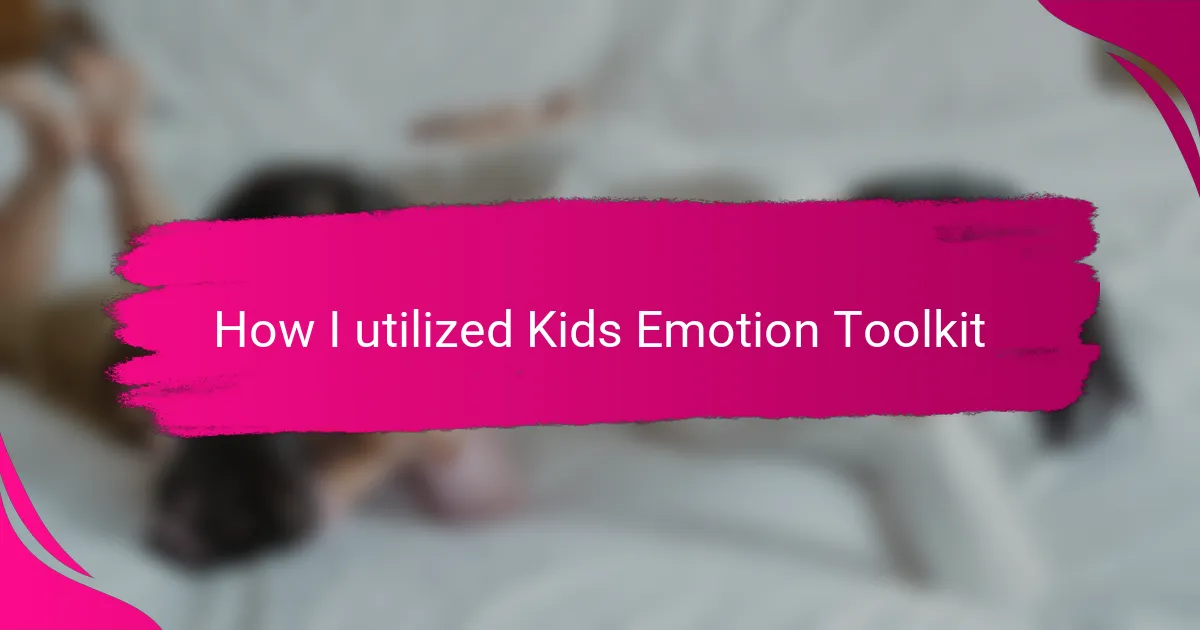Key takeaways
- The Kids Emotion Toolkit helps children recognize, name, and validate their feelings, fostering emotional understanding and confidence.
- Incorporating daily practices, such as using emotion cards and discussing feelings, strengthens communication and builds trust between parents and children.
- Overcoming challenges with patience and gentle encouragement deepens the emotional bond and teaches resilience and empathy.
- Long-term emotional growth is cultivated through consistency, curiosity about feelings, and modeling emotional skills as parents.
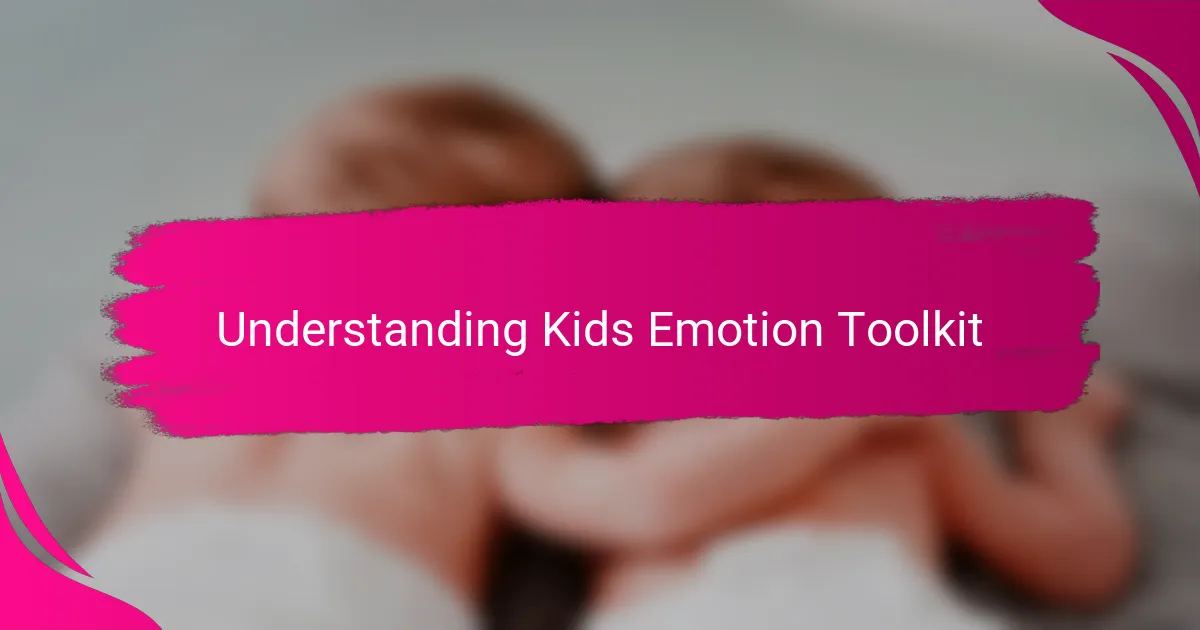
Understanding Kids Emotion Toolkit
When I first came across the Kids Emotion Toolkit, I was amazed at how simple yet powerful it was in helping children recognize and name their feelings. Have you ever noticed how often kids get overwhelmed because they don’t have the words to express what they’re feeling? This toolkit bridges that gap by giving them the language and confidence to share their emotions.
What struck me personally is how the toolkit isn’t just about labeling emotions but also about validating them. I saw my own child lighten up after using these tools, as if finally someone was saying, “It’s okay to feel this way.” It made me realize that understanding emotions isn’t just a skill for adults—it’s essential for kids too.
I often wonder why emotional education isn’t more common in schools or homes, given its huge impact. The Kids Emotion Toolkit made me reflect on how we adults approach feelings and how much more compassionate and patient we become when kids show us their inner world. It’s a game-changer in parenting, one I didn’t expect but now can’t imagine being without.
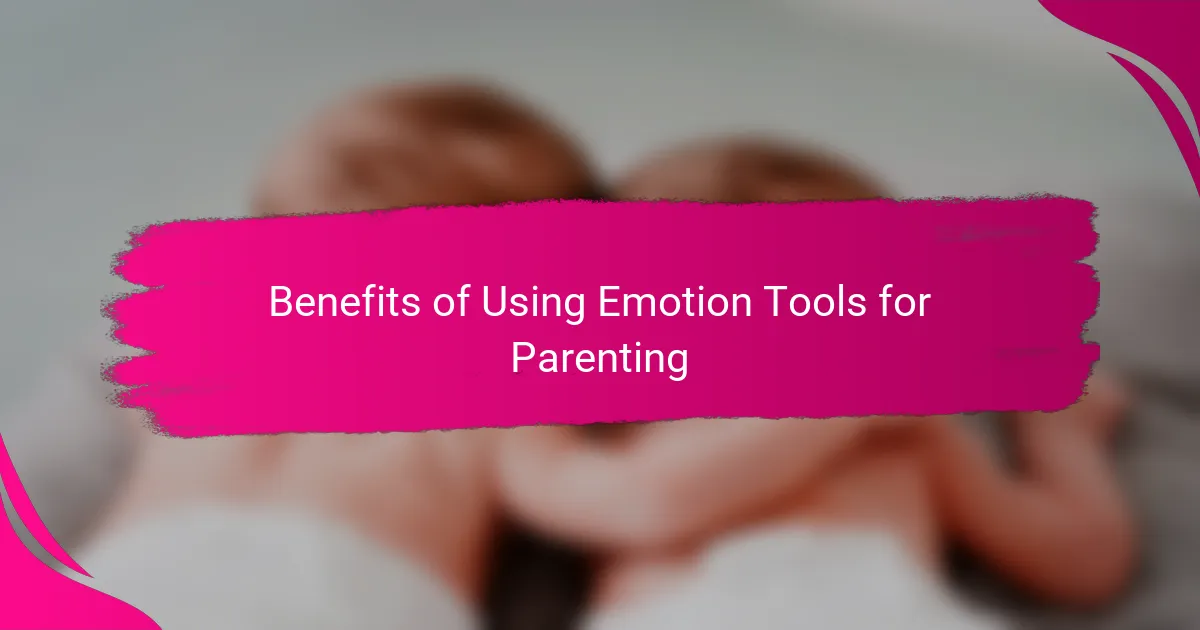
Benefits of Using Emotion Tools for Parenting
Using emotion tools in parenting has truly transformed the way I connect with my child. Have you ever struggled to calm a meltdown when you just don’t understand what’s really upsetting your little one? These tools help decode those moments, making it easier to respond with empathy rather than frustration.
One thing I noticed right away is how helping kids name their feelings reduces their anxiety. When my child learned to say “I’m sad” instead of just crying, it felt like a weight was lifted—not just for them, but for me too. It’s like giving them a flashlight in the dark, guiding us toward solutions instead of endless distress.
Another benefit I appreciate deeply is the boost in our communication. Kids feel heard and respected when they have the language to explain their emotions. That connection builds trust and makes parenting feel less like a battle and more like a team effort. Isn’t that what we all want—to feel understood by those we love most?
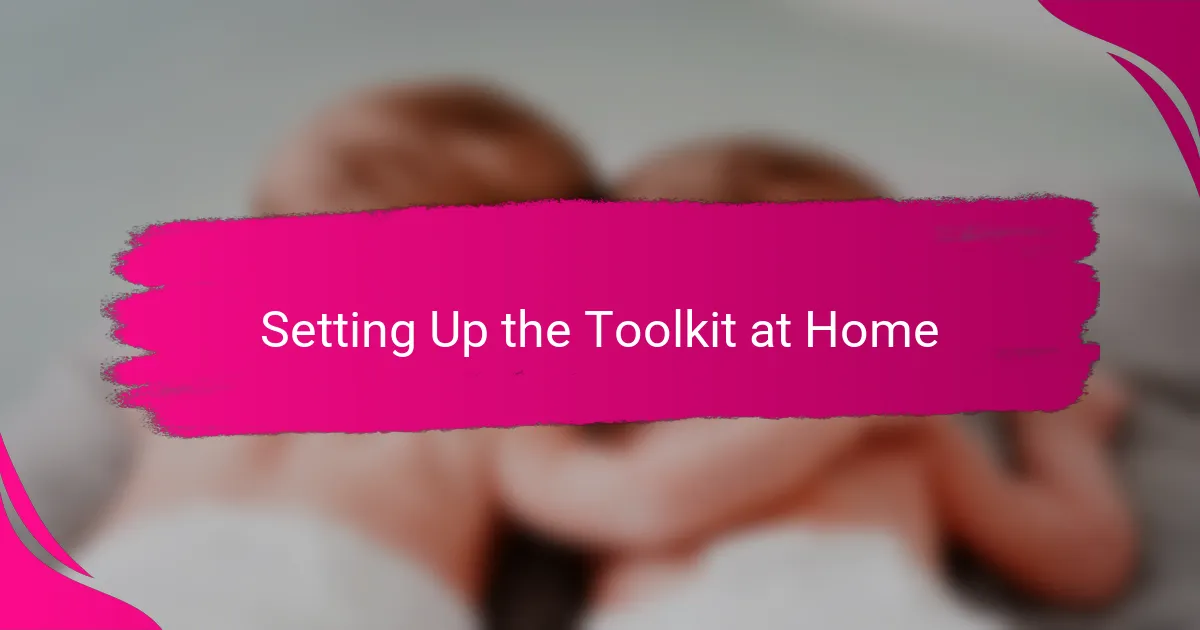
Setting Up the Toolkit at Home
Setting up the Kids Emotion Toolkit at home was surprisingly straightforward, but it required intentionality. I dedicated a small corner in our living room to keep the tools visible and accessible, so my child could reach for them whenever feelings bubbled up. Have you ever noticed how having something tangible nearby invites kids to explore their emotions naturally? That’s exactly what happened with our little setup.
To make the toolkit feel part of our daily life, I introduced it gently—no pressure, just curiosity. We spent a few minutes each day looking at the emotion cards together, and I shared stories about times I felt similar emotions. This made the process feel personal and safe, turning it into a cozy habit rather than a chore.
What surprised me most was how quickly my child started initiating the use of the toolkit. Seeing them grab a card or a feelings journal without prompting was a proud moment for me. It reminded me that creating a supportive space at home isn’t just about the tools—it’s about the message that their feelings matter, every single day.
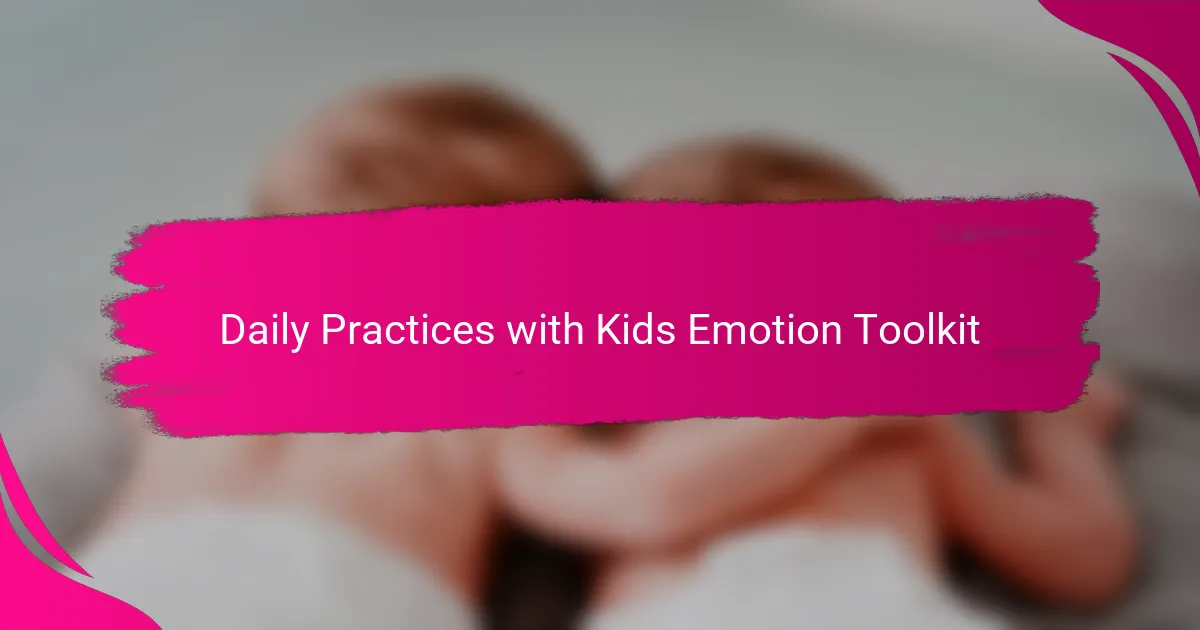
Daily Practices with Kids Emotion Toolkit
Incorporating the Kids Emotion Toolkit into our daily routine turned out to be more natural than I expected. Each morning, we’d spend just a few minutes checking in, using the emotion cards to name how we were feeling. This simple habit helped my child become more aware of their mood right from the start of the day—have you ever tried starting your day with that kind of emotional clarity?
One moment that sticks with me was during a particularly rough afternoon when my child picked up the toolkit unprompted after school. They flipped through the cards slowly and finally pointed to the one that said “frustrated.” It was like a light bulb went on for both of us; suddenly, I understood what was going on inside without any tears or tantrums. Do you recall a time when a small tool like that changed the whole atmosphere?
At dinner time, we’d revisit the toolkit together, reflecting on the emotions we experienced throughout the day. This reflection not only helped my child recognize patterns but also opened up space for reassuring conversations. Watching them grow more confident in expressing themselves made me realize just how important these daily practices are—not just for emotional skills, but for building trust and connection that lasts.
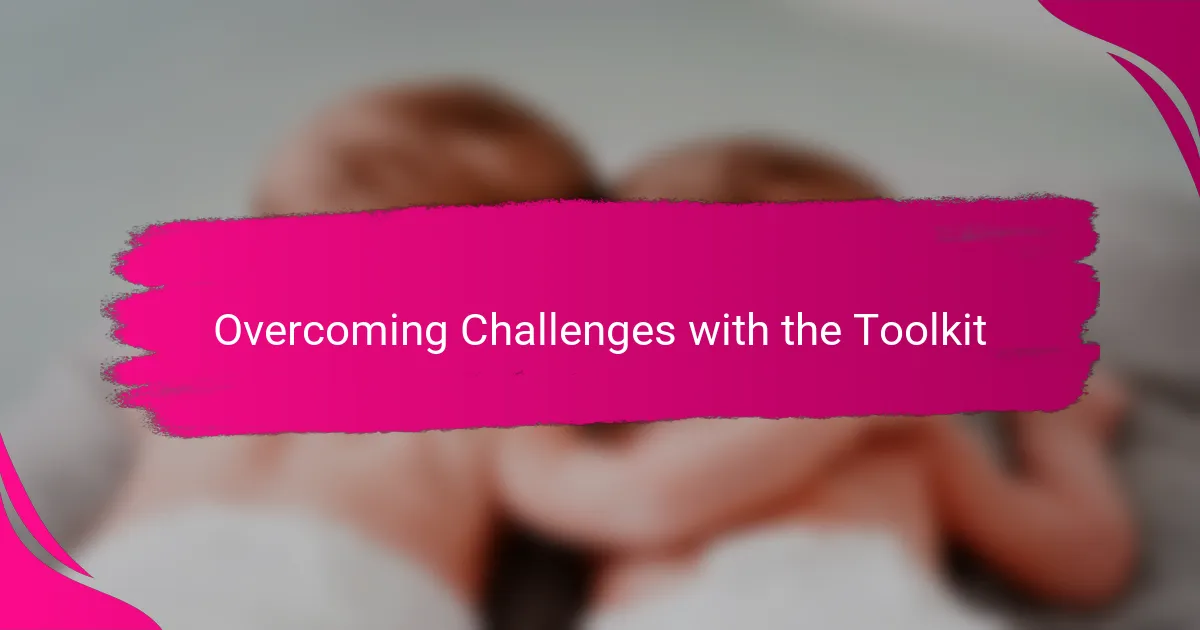
Overcoming Challenges with the Toolkit
Sometimes, despite the toolkit’s simplicity, we hit roadblocks—moments when my child was reluctant to use the tools or dismissed their own feelings. I learned that patience was key; gently inviting rather than insisting made all the difference. Have you ever noticed how pushing too hard can shut down a child’s emotional openness? Giving space allowed trust to grow naturally.
There were days when emotions ran so high that even naming them felt impossible. In those times, I relied on the toolkit’s comfort objects and visual cues to calm the storm instead of going straight for words. This experience taught me that overcoming challenges isn’t about perfection but about showing up consistently, even in small ways.
What surprised me most was how overcoming these challenges deepened our bond. Each hurdle became an opportunity to model resilience and empathy, demonstrating that it’s okay to struggle with feelings sometimes. Don’t you think that’s the most valuable lesson we can pass on—that emotions aren’t obstacles, but gateways to connection?

Real-Life Examples and Success Stories
One day, after a particularly rough morning, my child surprised me by grabbing the emotion cards and quietly pointing to “overwhelmed.” Seeing them use the toolkit on their own was a breakthrough moment—proof that these tools were becoming a trusted part of their emotional vocabulary. Have you ever experienced that subtle shift when a child takes the lead in their own emotional learning? It’s a game-changer.
I also recall a time when my child was struggling with frustration during homework. Instead of escalating, we turned to the feelings journal together, writing down the emotions and thinking through solutions. It transformed a tense situation into a collaborative problem-solving moment, deepening our connection in a way I hadn’t anticipated. Moments like these remind me how practical and powerful the toolkit really is.
Then there was the evening routine where, after talking through the day’s highs and lows, my child smiled and said, “I’m glad we have these cards—it helps me feel like you really get me.” That simple sentence was more rewarding than I can express. It made me realize that behind every tool is a bridge—one that brings us closer, one feeling at a time. Have you noticed how those small acknowledgments can quietly transform your relationship?
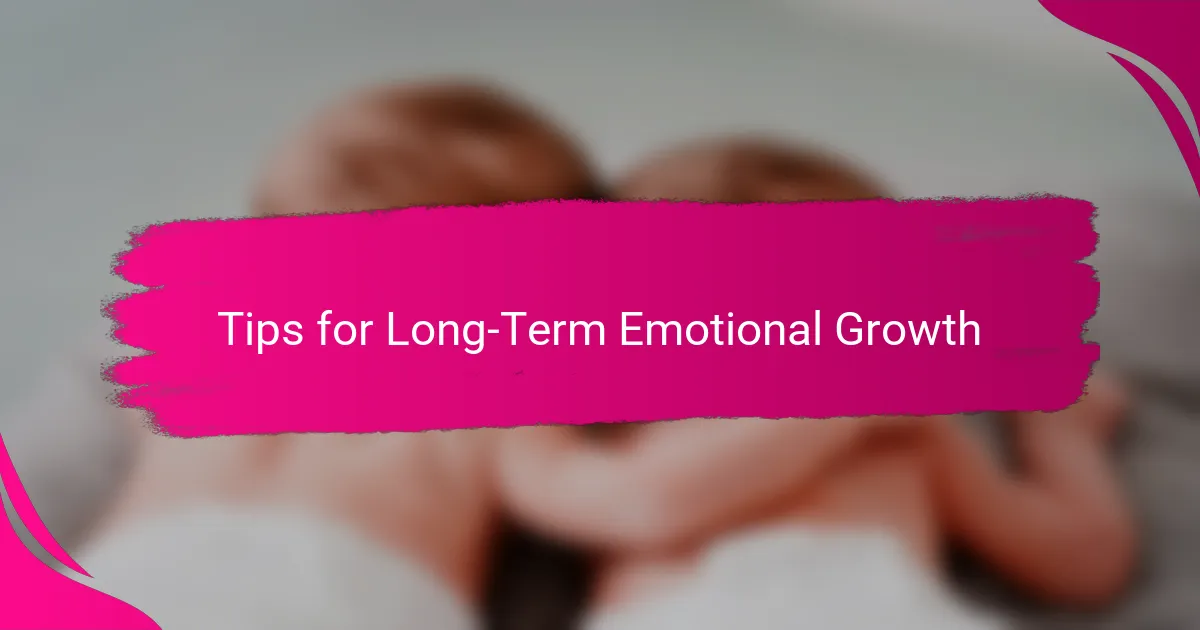
Tips for Long-Term Emotional Growth
When I think about long-term emotional growth, consistency is what comes to mind first. It’s not about one perfect moment with the toolkit but about weaving its use into everyday life. Have you noticed how even small, daily check-ins with emotions can build a foundation of self-awareness that lasts well beyond childhood? I’ve seen it firsthand—those tiny habits create a safety net that kids carry with them into the future.
Another aspect I value is encouraging curiosity about feelings without judgment. I try to remind myself that emotional growth isn’t a straight path; it has bumps and detours. When my child stumbles or struggles, embracing those moments as learning experiences rather than setbacks has made all the difference. Isn’t it comforting to think that even frustration or sadness can become tools for growth if we approach them with patience and openness?
Finally, nurturing emotional skills means modeling them ourselves consistently. Kids learn so much by watching us manage our feelings and communicate honestly. I find that sharing my own emotional ups and downs, in age-appropriate ways, invites my child to do the same. Have you ever noticed how vulnerability from a parent can empower a child to be more open? It’s a powerful cycle that keeps the toolkit alive and evolving over time.
